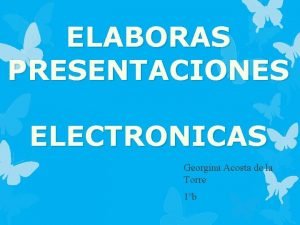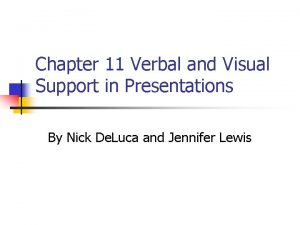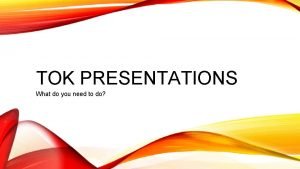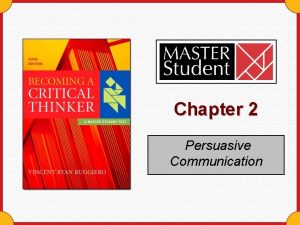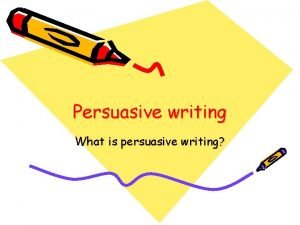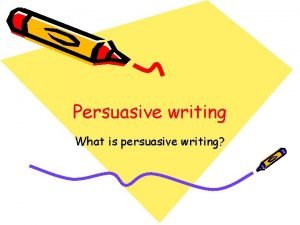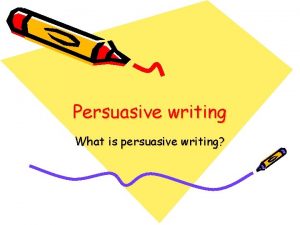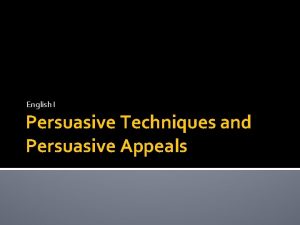Chapter 14 Persuasive Presentations What is Persuasion Persuasion









- Slides: 9

Chapter 14: Persuasive Presentations

What is Persuasion? • Persuasion is communication intended to influence choice. – To persuade is to limit the options that are perceived as acceptable. – Persuasion is not coercion. • Receivers weigh the logic and evidence and make their own decisions.

Types of Persuasive Presentations • Presentation to convince – You want your audience to agree with your way of thinking; you aren’t asking your audience to do anything other than agree with you. • Presentation to actuate – You want your audience to go one step past agreement to take a particular action

Four Main Factors of Persuasion • Logos – Evidence and logic of the message • Ethos – Credibility of the persuader • Pathos – Psychological needs of listeners • Opinions – Those held by key people in the audience

Evidence & Logic • Evidence is defined as factual statements and opinions originating, not from the speaker, but from another source. – Evidence is the basis for the logical arguments a speaker develops. • Logic (Greek word logos or reason) is the study of orderly thinking – the sequence and connection of thoughts and ideas as they relate to one another.

Fallacious Reasoning • Ad hominem- attacking the person rather than the argument • Ad populum- arguing that because everyone knows an idea is right, it cant be wrong • Ad ignoratam- arguing that because no one can prove that a particular belief is false, it must be true • Begging the question- asserting that something is because it is • Hasty generalization- basing a general conclusion on too few examples or on isolated examples • Post hoc- claiming a causal relationship simply because one event followed another event • Slippery Slope- asserting that taking a particular step automatically will lead to a second undesirable step.

Speaker Credibility • A credible person is someone whom others view as believable—someone in whom they can place their confidence. – Trustworthiness – Competency – Dynamism – Objectivity – Organizational Rank – Credibility

Psychological Needs of Listeners • Maslow’s Hierarchy of needs – Physiological Needs • Food, shelter, clothing, water, sleep, sexual attraction – Safety Needs • Job, financial security, law & order – Social Needs • Love, companionship, friendship – Esteem Needs • Pride, recognition from others, status & prestige – Self-actualization Needs • Becoming the best person one can

Persuasive Presentations: Preparation Steps • • Step 1: Analyze your audience and their needs Step 2: Write your exact purpose as a position statement Step 3: Determine your initial credibility Step 4: Research your topic and choose your presentation method Step 5: Decide how to organize your presentation Step 6: Prepare and Outline or Storyboard Step 7: Review your presentation to ensure it is ethical Step 8: Practice your presentation to gain confidence
 Craft of scientific presentations
Craft of scientific presentations Introduction to mental health awareness presentation
Introduction to mental health awareness presentation The worst powerpoint presentations
The worst powerpoint presentations What are multimedia presentations
What are multimedia presentations Slidetodoc
Slidetodoc Ventajas y desventajas de corel presentations
Ventajas y desventajas de corel presentations Developing oral and online presentation
Developing oral and online presentation What is verbal support
What is verbal support How to make a tok presentation
How to make a tok presentation Best and worst powerpoint presentations
Best and worst powerpoint presentations





